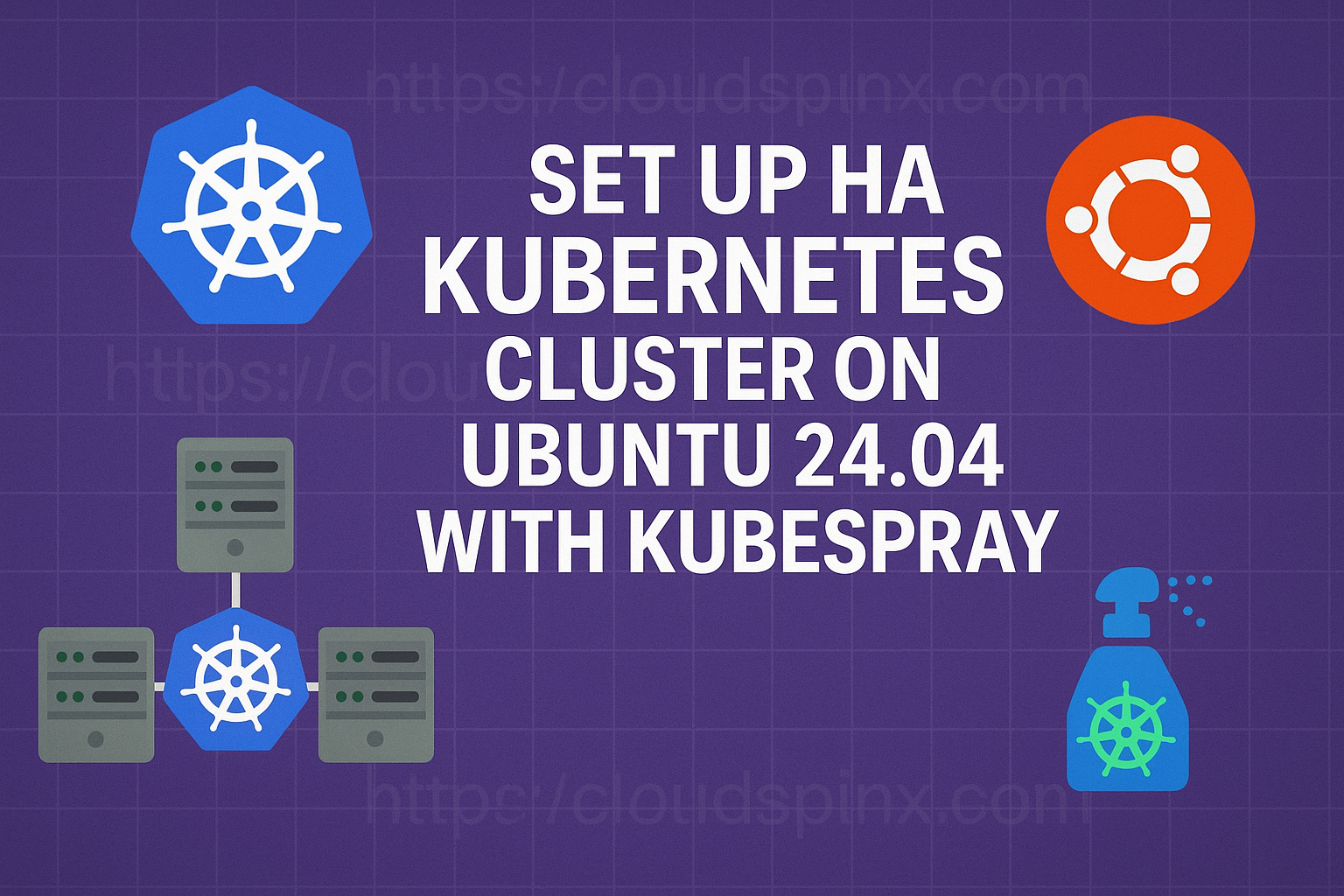Kubespray is an open source, production-grade automation tooling for the deployment and management of highly available Kubernetes clusters on Linux operating systems. It is based on Ansible, and it avails to you full lifecycle management of Kubernetes clusters running in Cloud, on-premise, or hybrid environments. In this guide, we’ll cover all the necessary steps when deploying a Highly Available (HA) Kubernetes cluster on Ubuntu 24.04 using Kubespray.
Why Kubespray for Kubernetes Deployment?
Kubespray delivers the following capabilities:
- Support for multiple clouds
- A highly customizable Kubernetes deployment options
- Native support for HA Kubernetes control plane
- Enjoys an active open-source community
Setup Pre-requisites
For this installation you will need:
1. Ubuntu 24.04 Machines – VMs or Baremetal
- At least 3 master nodes and optionally worker nodes
- SSH access to all nodes
- All nodes must have unique hostnames and static IPs
- Internet access on all machines
2. Workstation (Ansible Control Node)
You also need a separate machine, this can be your local machine with:
- Git
- Python 3.8+
- Ansible 2.14+
- Access to the Kubernetes nodes via SSH
- Internet Access
Step 1: Prepare Kubernetes Nodes
In this article, we are going to use the following machine configurations – The control plane nodes will be used as worker nodes.
| Server IP | Node Role | OS version |
| 192.168.20.18 | Control plane ( and Worker Node) | Ubuntu 24.04 |
| 192.168.20.19 | Control plane ( and Worker Node) | Ubuntu 24.04 |
| 192.168.20.20 | Control plane ( and Worker Node) | Ubuntu 24.04 |
However, it’s also possible to include separate, dedicated worker nodes. For example:
| Server IP | Node Role | OS version |
| 192.168.20.21 | Worker Node | Ubuntu 24.04 |
| 192.168.20.22 | Worker Node | Ubuntu 24.04 |
| 192.168.20.23 | Worker Node | Ubuntu 24.04 |
| 192.168.20.24 | Worker Node | Ubuntu 24.04 |
Ensure each node has:
- Static IP addresses configured
- SSH access enabled
- Static hostname (if not managing using Kubespray), set using
hostnamectlcommand.
Also disable swap on all nodes:
sudo swapoff -a
sudo sed -i '/ swap / s/^/#/' /etc/fstabFinally update packages on all nodes:
sudo apt update && sudo apt upgrade -y
[ -e /var/run/reboot-required ] && sudo rebootStep 2: Configure Ansible Control Node
Login to your Ansible control node, and install the following Python packages.This can be any OS:
- Debian / Ubuntu:
sudo apt update
sudo apt install git python3-venv python3-full
sudo apt remove ansible ansible-core 2>/dev/bull- Rocky / AlmaLinux 9:
sudo dnf -y install git python3.11Create Virtual Environment for Kubespray:
- Debian / Ubuntu:
VENVDIR=kubespray-venv
KUBESPRAYDIR=kubespray
python3 -m venv $VENVDIR- Rocky / AlmaLinux 9::
python3.11 -m venv $VENVDIRClone the Kubespray Repository
git clone https://github.com/kubernetes-sigs/kubespray.gitActivate Virtual Environment:
source $VENVDIR/bin/activateSwitch into kubespray directory:
cd kubesprayCheck out to the relevant tag – See Kubespray releases page on Github:
git checkout <TAG> # Example git checkout v2.27.0Install required dependencies defined in the requirements.txt file:
pip install --upgrade pip
pip install -U -r requirements.txtIf the installation fails, try adding the --break-system-packages flag.
Verify version of Ansible installed:
$ ansible --version
ansible [core 2.16.14]
config file = /root/kubespray/ansible.cfg
configured module search path = ['/root/kubespray/library']
ansible python module location = /usr/local/lib/python3.12/dist-packages/ansible
ansible collection location = /root/.ansible/collections:/usr/share/ansible/collections
executable location = /usr/local/bin/ansible
python version = 3.12.3 (main, Feb 4 2025, 14:48:35) [GCC 13.3.0] (/usr/bin/python3)
jinja version = 3.1.4
libyaml = TrueCopy the sample inventory:
cp -rfp inventory/sample inventory/cluster1Create inventory file to reflect your topology. If you want to separate control plane nodes from worker nodes, make the necessary adjustments; otherwise, if they are shared, you can leave the configuration as is.
vim inventory/cluster1/hosts.yamlExample configuration:
all:
hosts:
k8smas01:
ansible_host: 192.168.20.18
ip: 192.168.20.18
access_ip: 192.168.20.18
k8smas02:
ansible_host: 192.168.20.19
ip: 192.168.20.19
access_ip: 192.168.20.19
k8smas03:
ansible_host: 192.168.20.20
ip: 192.168.20.20
access_ip: 192.168.20.20
children:
kube_control_plane:
hosts:
k8smas01:
k8smas02:
k8smas03:
kube_node:
hosts:
k8smas01:
k8smas02:
k8smas03:
etcd:
hosts:
k8smas01:
k8smas02:
k8smas03:
k8s_cluster:
children:
kube_control_plane:
kube_node:
calico_rr:
hosts: {}If you are using the Jump server/Bastion host to access Kubernetes nodes, change IPs accordingly.
In most cases, you’ll be updating the kube_node group to include additional worker nodes. As an example:
all:
hosts:
k8smas01:
ansible_host: 192.168.20.18
ip: 192.168.20.18
access_ip: 192.168.20.18
k8smas02:
ansible_host: 192.168.20.19
ip: 192.168.20.19
access_ip: 192.168.20.19
k8smas03:
ansible_host: 192.168.20.20
ip: 192.168.20.20
access_ip: 192.168.20.20
k8snode01:
ansible_host: 192.168.20.21
ip: 192.168.20.21
access_ip: 192.168.20.21
k8snode02:
ansible_host: 192.168.20.22
ip: 192.168.20.22
access_ip: 192.168.20.22
children:
kube_control_plane:
hosts:
k8smas01:
k8smas02:
k8smas03:
kube_node:
hosts:
k8snode01:
k8snode02:
etcd:
hosts:
k8smas01:
k8smas02:
k8smas03:
k8s_cluster:
children:
kube_control_plane:
kube_node:
calico_rr:
hosts: {}Step 3: Customizing Kubernetes cluster settings (Optional)
Edit k8s-cluster.yml file to customize cluster settings before deploy:
vim inventory/cluster1/group_vars/k8s_cluster/k8s-cluster.yml- Enable strict ARP:
kube_proxy_strict_arp: true- Enable nodelocal dns cache
enable_nodelocaldns: true- Setting network plugin:
kube_network_plugin: cilium- Kubernetes internal network for services:
kube_service_addresses: 10.233.0.0/18- Internal Pods network:
kube_pods_subnet: 10.233.64.0/18- Container runtime:
container_manager: containerd- Automatically renew K8S control plane certificates (monthly):
auto_renew_certificates: falseAdditional Addons
Edit the addons.yml file to adjust customizations for additional services
vim inventory/cluster1/group_vars/k8s_cluster/addons.ymlFor example:
- Kube VIP ( Configure this for HA Control Plane)
# Kube VIP
kube_vip_enabled: true
kube_vip_arp_enabled: true
kube_vip_controlplane_enabled: true
kube_vip_address: 192.168.20.10 # Set correct virtual IP to be used
loadbalancer_apiserver:
address: "{{ kube_vip_address }}"
port: 6443Optionally, you can configure an A record in your DNS server to map the kube_vip_address IP to your Kubernetes API endpoint DNS name.
For example:
192.168.20.10 k8sapi.cloudspinx.com- Enable Kubernetes Dashboard:
dashboard_enabled: false- Metrics Server deployment
metrics_server_enabled: true- Cert manager deployment
cert_manager_enabled: trueIf you want to disable Kubespray setting the hostname to inventory_hostname, edit:
$ vim roles/bootstrap-os/defaults/main.yml
override_system_hostname: true # Set false to use manually set hostnamesStep 4: Deploy Kubernetes cluster on Ubuntu 24.04
If using LB, configure it in inventory/cluster1/group_vars/all/all.yml before you start cluster installation.
## External LB example config
## apiserver_loadbalancer_domain_name: "elb.some.domain"
# loadbalancer_apiserver:
# address: 1.2.3.4
# port: 1234Below is a list of commonly used Kubespray options:
| Option | Description |
|---|---|
-i (Inventory) | Specifies the inventory file for hosts |
-b, --become | Runs the playbook with sudo (privileged) access on the target nodes |
-v, --verbose | Increases verbosity of the output. Use multiple v for more verbosity (-vv, -vvv) |
--private-key | Specifies the private SSH key for authentication |
--limit | Limits the playbook run to specific hosts or groups |
--extra-vars | Passes extra variables that override default configurations |
--check | Runs the playbook in “dry-run” mode without applying changes |
Initiate Kubernetes cluster deployment on Ubuntu 24.04 using Kubespray:
ansible-playbook -i inventory/cluster1/hosts.yaml --become --become-user=root cluster.ymlThe process may take more than 10 minutes depending on your cluster size.
Step 5: Access Kubernetes Cluster
After successful execution of the playbook, copy kubeconfig from one of the control-plane nodes:
cd ../
NODE1=192.168.20.18
scp root@$NODE1:/etc/kubernetes/admin.conf ./k8s-kubeconfigIf you have Kube VIP enabled, you will see https://lb-apiserver.kubernetes.local:6443
apiVersion: v1
clusters:
- cluster:
certificate-authority-data: LS0tLS1CRUdJTiBDRVJUSUZJQ0FURS0tLS0tCk1JSURCVENDQWUyZ0F3SUJBZ0lJUkRIT1QxVnRxVzR3RFFZSktvWklodmNOQVFFTEJRQXdGVEVUTUJFR0ExVUUKQXhNS2EzVmlaWEp1WlhSbGN6QWVGdzB5TlRBME1UWXhNRE16TkRSYUZ3MHpOVEEwTVRReE1ETTRORFJhTUJVeApFekFSQmdOVkJBTVRDbXQxWW1WeWJtVjBaWE13Z2dFaU1BMEdDU3FHU0liM0RRRUJBUVVBQTRJQkR3QXdnZ0VLCkFvSUJBUUNtZHFDbXJhN29KMGoxSE1MaFRlS3hxUlI1M01XWDNnQ2hMa0dtVlpMd3BUWjBZbXVsMXEwU2dMdm4KdCt0dXJLV3V5VjBLY2lwbVpYZXJQT2tNTElQK0lBVWpXTmUwWEhEbVIyQjlLZnpWWVJFVE9BUTdaSC9XNzhlMAp4Y2kwcjVZU3Y0V0V5QjUyUGRkbXdRcXMzeE52RXJveDlPbzBwa1krekVlNFNtWmI2NXRZNmpTZkRmZDZUcVRlCmhVUjI2eUlQTHJYVWVTNk1yV3FZWmJyOGZIZ3ZkaGtXcURLUkFlU0VCOHBFb2lqcnlpZzBVanc1QURheXFoL2EKNmowODNIWVZ2d3VsR0ZjT3hsNko4QXcvWTV4bmRidDNnQ2t6d3hjSU1ybkdHWitua1VxS1dNQkoxWEpRNWR5ZQorOHorOFJIVWJPZ1dJYzNncU5mdFVwQzZHV24zQWdNQkFBR2pXVEJYTUE0R0ExVWREd0VCL3dRRUF3SUNwREFQCkJnTlZIUk1CQWY4RUJUQURBUUgvTUIwR0ExVWREZ1FXQkJTNTVSS0VNa1VOb1p4a0lidEpNQ2NNRFRiTWZ6QVYKQmdOVkhSRUVEakFNZ2dwcmRXSmxjbTVsZEdWek1BMEdDU3FHU0liM0RRRUJDd1VBQTRJQkFRQkIvYXpPNmRjKwpRK3pzK3pYbjd1dUVBbVBXVnl1c1BVZGw0c2dxSVNjMjh2OENndGhsekNNSndqcjdTNm8xRGlRNGtCOWd0clViCnkvUVJZYU1tb0tCR1VVWGpod1FtV1YyN0Juc1kxOHd4RG1wd3EySHVYQktjUXUzUTRKQ1BaWVFicDV1Yyt5L2EKT2llanhiaEdRaUxnQi9tMEdXN3hXRGdiZWx0UXhWbm4rYXo2UVZ2M2J1VkIxWGZwQllPRlZEdU1XZFAzcDQrdQpGNGxITDhxaXdNbm1MeG5hYTJMMGpxcFFreXYvRGF5dkdzQTZxTjdrVjZQT3VRU0ROYXF3VmpOV2h3RTVnRmtsCjZQcnN4NkR0azhIU1ZpQzliaFdUVStxb0xJUjArLy9HUHFpMVlLb1crSytwMDJrWXhJeEZnd3JUdWZMZVBJM0YKVHR3Wm1FaDhuY0UvCi0tLS0tRU5EIENFUlRJRklDQVRFLS0tLS0K
server: https://lb-apiserver.kubernetes.local:6443
name: cluster.local
contexts:
- context:
cluster: cluster.local
user: kubernetes-admin
name: [email protected]
current-context: [email protected]
kind: Config
preferences: {}
users:
- name: kubernetes-admin
user:
client-certificate-data: LS0tLS1CRUdJTiBDRVJUSUZJQ0FURS0tLS0tCk1JSURLVENDQWhHZ0F3SUJBZ0lJTTI0M2tHOC9HYUl3RFFZSktvWklodmNOQVFFTEJRQXdGVEVUTUJFR0ExVUUKQXhNS2EzVmlaWEp1WlhSbGN6QWVGdzB5TlRBME1UWXhNRE16TkRSYUZ3MHlOakEwTVRZeE1ETTRORFZhTUR3eApIekFkQmdOVkJBb1RGbXQxWW1WaFpHMDZZMngxYzNSbGNpMWhaRzFwYm5NeEdUQVhCZ05WQkFNVEVHdDFZbVZ5CmJtVjBaWE10WVdSdGFXNHdnZ0VpTUEwR0NTcUdTSWIzRFFFQkFRVUFBNElCRHdBd2dnRUtBb0lCQVFEQ1BORFoKNlNSYkV0T0FBM3BDY0xndWNVVXhWMmFYUHQrM3JpRmpsRVBmQjNGeVROWGhtZGpWRWpaRjIvVTRSS01LK1FPZwoyc0hXTGxzTjBjb0dYWnJRUTZGWFh4bUdNdDRCdUFNZWFQQ1pCRWZtcnlJeWlwQVNrSzVoeklPMmkrUTRGZlRSCk9IK2RIUGxGV3BWWThSQndXZ2t1R25nVzhLUHd4MjdoczlPOGNkWkFxZEFLZUMrT0UxaFdnalY4UzAyb2Y4TzMKZFRMRUNOYW9abHJ3T2x1Z1FxejFKaEZsbEZTR0hCbkFsT1J1ZlY0MWdqMWFtU0NyU1RRWGFnWU9VbE8yU0tZSQpkdXV0bThWS2xUQU8vRldSRyt6RWFMUU1pTkNpbUpGa3cvTC83NEJURFhySUR4V0Njd0MrYU5aNEhEQjFLc01LCm1rckhqK3B2QmkwZURuTG5BZ01CQUFHalZqQlVNQTRHQTFVZER3RUIvd1FFQXdJRm9EQVRCZ05WSFNVRUREQUsKQmdnckJnRUZCUWNEQWpBTUJnTlZIUk1CQWY4RUFqQUFNQjhHQTFVZEl3UVlNQmFBRkxubEVvUXlSUTJobkdRaAp1MGt3Snd3Tk5zeC9NQTBHQ1NxR1NJYjNEUUVCQ3dVQUE0SUJBUUNGMFcxa3ZqNmpKVStiK2hranlWSkZkTXNLCm51bVJuVGt0eTROVjg3aDR2cFpJWThnOHFBLzNrcVJGUkNwN2hydlgyd04rbU1sSWhMVDFmYXJSZTl5SFVJaEUKRk1HeGFvdURvSER1SkZ6L05KTnZyQk9KMTkrQkwwRlJSQVplQkpFOUdsVGYzVGxPZTRYaG5NTjFvOWVqTXVPSwpUdWh1VEdXSHVFaVlCMmhOZm9ON1FzbWhiMlVxd0xWYkdEMTZzbDZIejdRaFhSNlNVaDNiNExHWkhqUmpCUStaCmxzUDNseHVQNk1SRWFONCsrVWtmQ2hOUVpySlNqSXovVG11MWtXOTVwM3hjVHM4WWR5b0hqY294eCtLY1dSdkoKMTFZS0JMem9oRzQzN2M4UHZqckRjaGUrV2RYb0NyaFZnKzkzbUF5WEUvWktxT3ZtRDNsVUo5R1RKdGpiCi0tLS0tRU5EIENFUlRJRklDQVRFLS0tLS0K
client-key-data: LS0tLS1CRUdJTiBSU0EgUFJJVkFURSBLRVktLS0tLQpNSUlFb3dJQkFBS0NBUUVBd2p6UTJla2tXeExUZ0FONlFuQzRMbkZGTVZkbWx6N2Z0NjRoWTVSRDN3ZHhja3pWCjRablkxUkkyUmR2MU9FU2pDdmtEb05yQjFpNWJEZEhLQmwyYTBFT2hWMThaaGpMZUFiZ0RIbWp3bVFSSDVxOGkKTW9xUUVwQ3VZY3lEdG92a09CWDAwVGgvblJ6NVJWcVZXUEVRY0ZvSkxocDRGdkNqOE1kdTRiUFR2SEhXUUtuUQpDbmd2amhOWVZvSTFmRXROcUgvRHQzVXl4QWpXcUdaYThEcGJvRUtzOVNZUlpaUlVoaHdad0pUa2JuMWVOWUk5Cldwa2dxMGswRjJvR0RsSlR0a2ltQ0hicnJadkZTcFV3RHZ4VmtSdnN4R2kwRElqUW9waVJaTVB5LysrQVV3MTYKeUE4VmduTUF2bWpXZUJ3d2RTckRDcHBLeDQvcWJ3WXRIZzV5NXdJREFRQUJBb0lCQUhHQkNtYWNoK00wZ0NWcApZdE5hZlRhZWVGbWFBbGhWcEhQNHJJZzlSdUFZd0dHVHB0UjdpNnNQUm1uU1hGenlOdmlkaFZKRkkwcGVzbFRFCkNETnFGYUtvTXFzVTVweDJNeWQ3K1U2Vzhpbm94MzkxVGgyTXZSNHNMOHIwc085R2xpbDBJeWp6eEJieXJIT3IKdUdST0VsWWxOd0lhODV3c0tSRDE2Y1M0eWYxdTNXU3RTaWh1ZSt4ZWpDOXpQY0RrMkJMZVdwUDBRUGlhemNEKwpUeTkwKzFEUGV1UDFtV1pOMENKUHNmMHNyeGN1WlBtcXc2b1hDY1lOUkNncE0yQlg1YjUxSHBpdkV3SVBIRjRJCk9XUDdQaERLSTM0djhzM3dwWUFGQlI4NWs3ZDhxcy9aa1pKOE40a1Nmc1ZqbTNrUjZpSUhkZVhlcmZHeUhwMmkKWkNkdmxGRUNnWUVBdzB4NGxxNlE1QXNHWmw4Wk9ldEhWMnlCclRUZnBaMTM1K0VCQm54UmRrTFY2VEkrczJBKwoyZmc2a3JMN25qSWg1dFR6clhrUnRNeHZBSGJKM1NNNVVndTJManJET0s1OCt1czBmYzNuWDF4MjNzWGplYWFWCk5zSml2OVBNMXFXMFNad0hQa3o1d1ZvSjNMVTMvZWNEVW1Xd01CLzVTRFF3eHJxOWZqRUxpSDhDZ1lFQS9wdnAKTXRtZHpWa0ttaFBQWWZYUXNQTk8zSktZVEpycHZld3EyRnlLRG5GMENoN1hKNXZlbmZMRjBXRkpEck4zaFVFRgpURjRWeHdjYlVsVm9mS2NVZ0NFN09HTllkTjU0enlOQ1dpTHhpSGJqUW5kVUJDUGZEbTVCSW50UEoycEFjR2YvCkc0OE5OcWdqeUUzUDlkajBOdVIzVlJUd1J2b0ZGdFRURWJtdW9aa0NnWUVBcDV2WW5sRkJEa1diLzMyOFU2WGwKdTFUblVmUmZ3RzROZXhieTMxTVFRck9IakRSUDlYZ3pXTFFkNk1ydEFVNjdJN1U5VUhMb1RFZHJPSFc2Tnl4RQp4SEpDcnhoRmRUN2pDaUdVRWlnRld5VXE2M1BnRHdaMVp1S2JCMURKcXFuWnVaYkw3Sjc1ZGdSRkZJTCtnOHlnCllEWGZhTjMzL2d5MGs4bXVXVC9VU3hjQ2dZQlhPNmZjYWo3c3VsTXRreGY4b2pJTVRuQjRsaWxrSmJkc0FOeDEKSU0rVVB6N1lzTlJhbDhiZ0t1dW4zME1lckZLSTcwd1hiQ3pkOGd0a1hDcmVlb2hGbGgwcUpxK0o2eWROSVBGOAozSGdRbjFzaHpLeVdkb3ZYNytLVkk5WnMxTFNiVHFaVEZPSWNGZU9jbnp4ZktTUVRJcGZZS01KaUx3dExWVU96CjBRQ0tFUUtCZ0NtQ1B3VkxlQ3p5STVpdHZaK0RGaHB4K0VTMHBYZ2VsZVdad1NNS0JKa1VOWjFCdElZRFludFQKNDBreFJGT2RuNUk1bUhNUWRyM3FrWi8zUmorM0tVaU0xYkhOaUJETy9BOWFobndTZEt0b2gwNlprbE0zZzhaUgptQzFGbUtGOWlDditPTE5Dd1hEcGc4NmtMcU91Q1BzRStVRUZTY3pTelNLb0EyTXN6TkszCi0tLS0tRU5EIFJTQSBQUklWQVRFIEtFWS0tLS0tCg==Add mapping for VIP to hostname in /etc/hosts file.
$ sudo vim /etc/hosts
192.168.20.10 lb-apiserver.kubernetes.localSet copied kubeconfig in KUBECONFIG env variable:
export KUBECONFIG=./k8s-kubeconfigTest access to your newly created kubernetes cluster using kubectl:
$ kubectl get nodes
NAME STATUS ROLES AGE VERSION
node1 Ready control-plane 18m v1.31.4
node2 Ready control-plane 18m v1.31.4
node3 Ready control-plane 17m v1.31.4Uninstalling Kubernetes using Kubespray
The reset.yml playbook is used to uninstall Kubernetes from the nodes.
ansible-playbook -i inventory/cluster1/hosts.yaml --become --become-user=root reset.ymlConfirm with ‘yes‘ when prompted to proceed with cluster deletion
Remove leftovers
Then run the following command to clean up any leftovers (if any):
ansible all -i inventory/cluster1/hosts.yaml -m shell -a \
'rm -rf /etc/kubernetes /etc/cni /opt/cni /var/lib/etcd /var/lib/cni /var/lib/kubelet /var/run/kubernetes /var/lib/containerd /etc/systemd/system/kubelet.service.d /etc/containerd'References:









